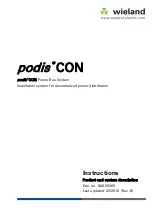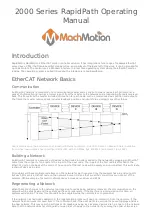
3
podis CON flat cable
10
Wieland Electric GmbH | BA000369 (Rev. B) | 02/2016
Table 2: Current-carrying capacity of
podis
®
CON
flat cable EVA 7G4 mm ² (00.709.0504.1)
In the open d > 10 mm
Loose on wall or floor
Cable duct
Loaded cores
3
5
6
3
5
6
3
5
6
Ta [°C]
Max. cross current
Max. cross current
Max. cross current
20
40
35
35
40
32
32
35
30
25
25
40
35
35
35
32
30
35
30
25
30
40
35
32
35
30
25
32
25
25
35
35
32
30
32
25
25
30
25
25
40
35
30
30
30
25
25
25
20
20
45
32
30
30
25
20
20
25
20
20
50
30
30
30
25
20
20
20
20
16
3.2
Notes on routing of flat cables
The flat cable is convenient and easy to handle and install. Some rules apply to the installation and rout-
ing, which are described in the following.
General instructions and precautionary measures
The
podis
®
flat cable is operated in grids with grounded feeds (TN-S networks). A floating installation of
podis
®
systems is not permitted.
CAUTION
•
The flat cable may only be commissioned if it is in a faultless condition and does not exhibit any damage to or openings of the
sheath.
•
Unused connections, outlets or devices on the flat cable must be sealed off using the corresponding measures (lids, blind plugs,
etc.). It is not permitted to work on or operate the flat cable with open connections, outlets or devices.
•
When conducting any working operations on the flat cable (assembly, maintenance, installation, etc.) the power must be turned
off.
•
The flat cable must always be closed off using the suitable end caps (see ordering instructions) due to the required air gaps and
creepage distances. It is not permitted to operate the flat cable with open ends or using other sealing solutions than the end caps
prescribed herein.
NOTE
Openings in the sheath caused by the insulation-piercing termination must be sealed using the sealing collar (see ordering in-
structions).
Monitoring and safety devices
Depending on the field of application, different components and protective measures are required to
complete a system or installation. The type of components and the level of obligation associated with
these protective measures depends on which VDE guideline affects your system or installation. Please
take note of Section 1 in this regard as well.
The assignment of safety guards to protect from short-circuits of cables and lines of the main or auxiliary
circuits outside of switchgear combinations must be conducted under consideration of the loop imped-
ance. DIN VDE 0100 Part 430 is to be applied in this regard.
The flat cable must be protected against overloads and short-circuits using a three-phase 16A (I
nominal
) cir-
cuit breaker with tripping characteristic class C. The tripping current is between 8 and 10 I
rated
in this case
(EN 60898, DIN VDE 0641 Part 11 and IEC 898). The auxiliary circuit must be protected by a single-phase
16 A (I
rated
) circuit breaker with tripping characteristic class C. Emergency stop devices (in accordance
with IEC 204, complies with DIN VDE 113) must be available. Their functioning may not be impaired in
any way.











































